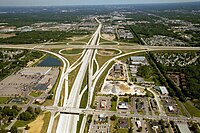
Photo from wikipedia
Abstract In the past two decades, passive control strategies using isolation and fluid dampers have been employed for the seismic protection of bridge highway structures. The isolation vibration control, however,… Click to show full abstract
Abstract In the past two decades, passive control strategies using isolation and fluid dampers have been employed for the seismic protection of bridge highway structures. The isolation vibration control, however, lacks the adaptability to react in real-time for changes during unpredictable earthquake loadings. This research advances the idea of combining the conventional passive control (base isolation) with a semi-active or active control system to create the next generation of smart bridge structures. A novel control algorithm based on the evoluationary game theory concept of replicator dynamics is investigated for vibration reduction of highway bridge structures equipped with both a passive isolation system and semi-active control devices subjected to earthquake loadings. The proposed methodology is evaluated by application to a benchmark example based on Interstate 5 overcrossing California State Route 91 (abbreviated as 91/5) bridge in southern California subjected to near-field historical earthquake excitations. Substantial reduction in mid-span displacement is achieved compared with the conventional base-isolated bridge.
Journal Title: Engineering Structures
Year Published: 2019
Link to full text (if available)
Share on Social Media: Sign Up to like & get
recommendations!